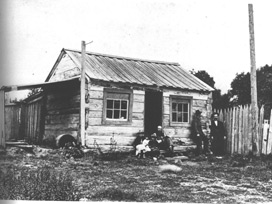Green Building - A History
 Humans
have been building shelters for thousands of years, and for most of that
time this buildings were hand made of local materials and were often adapted
to their climates. During this period, energy either scarce or
required significant effort to gather, and certainly was not available at
the flick of a switch. Since most of the labor was done by hand,
shelter tended to be quite small in size. Although these shelters were
void of man-made chemicals, they were not necessarily healthy, as they were
undoubtedly prone
to being dusty, moldy and smoky. The implications of these pollutants
is generally limited because the shelters were very drafty.
Humans
have been building shelters for thousands of years, and for most of that
time this buildings were hand made of local materials and were often adapted
to their climates. During this period, energy either scarce or
required significant effort to gather, and certainly was not available at
the flick of a switch. Since most of the labor was done by hand,
shelter tended to be quite small in size. Although these shelters were
void of man-made chemicals, they were not necessarily healthy, as they were
undoubtedly prone
to being dusty, moldy and smoky. The implications of these pollutants
is generally limited because the shelters were very drafty.
Up until the industrial age, building technology advanced to allow for much larger and more ornate building to exist. The only real difference between them and their predecessors, is that their main concern now is only with style and status, a fact that lingers to this day. (For an entertaining look at this read Witold Rybczynski, "Home- A Short History of an Idea")
Industrial Age Homes (1880-1970)
The industrial revolution brought both manufactured products and readily available energy into shelter design, resulting in standardized materials and designs, as well as an enormous increase in their use of energy. Over time, standardized building codes and building techniques generally improved the quality of the building.
During this time, our population increased dramatically and migrated toward the cities. Standardized construction, mass produced building materials and cheap transportation capable of moving both goods and people resulted not only in larger cities, but a new concept called suburbia, which is organized around the car.
Even before the onset of suburbanization, most eastern forests had been liquidated, resulting in much of the country's wood coming from western forests. Industrialization and cheap transportation fed this trend to the point where few homes were built with local materials.

Toward the end of this period, wood started to become a scarce (and hence more expensive) resource, resulting in many new wood fiber composite manufactured products in addition to the introduction of plastics, most of which are derived from petroleum. In some cases, these manufactured materials out-perform their replacements. Although many of these new materials are later found to produce small amounts of toxic gases, houses of the period are so drafty that the gases are rapidly diluted by fresh air, preventing any problems.
In larger buildings, steel and concrete had already replace stone allowing builder to build things like skyscrapers that were previously unimaginable. These products spur architectural styles that were previously impossible; in the process things like climate adaptation are largely ignored.
Manufacturing efficiency and low cost energy allow more people than ever to own homes. While initially, mass produced homes tended to get smaller as the American family size shrunk, after 1950 this trend reversed and the average size of a home began increasing even though average family sizes continued to shrink.
Houses of this era are, while much improved over their predecessors, consume energy at a high rate because they are un-insulated, drafty and not climate adapted.
Post Energy Crisis (1974) Homes
Even before the oil embargo, people dissatisfied with suburbanizion and mass produced homes began to look at things like solar energy and owner built shelter.
The oil embargo of 1974 brought a rapid, although somewhat temporary end to the availability of cheap oil, and America responded by building more energy efficient homes, although the size of the home continues to go up. This also produced a much greater interest in alternatives approaches to housing, and in this period the solar power movement is born, which itself is the beginnings of the green building movement.
By the 1980s many of these early highly insulated homes developed problems, such as rotten wood inside walls, mold, sick building syndrome and fogged dual pane windows. The field of building science developed to address these issues, which were mostly unintended consequences, by studying exactly how building work. In addition, as manufactures gained experience, products aimed at energy efficiency improved greatly.
The energy crisis, although prominent in many people's minds, did not last long, and in only a short time energy returned to being as cheap as ever with devastating effects on the solar power industry. At the same time, average house size grows even faster than before, and with it comes the "Starter Castle" or "McMansion", a house dramatically larger than typical, but housing a continually shrinking, and increasingly not uniform family unit.
The Birth of Green Building
Unlike the energy crisis of 1974, there is no defining moment for the beginning of green building. Because of the energy crisis and increased environmental awareness, the green building idea never really went away. Instead it continued to be developed by a small group of dedicated people, who were also launching the natural building movement.
At this point (2010) green building is on the radar like never before along with climate change, oil dependence, sick building syndrome, water efficiency, and general environmental degradation. There are green building programs, green rating systems and sometimes even government incentive programs in many areas now, but in spite of that, conventionally building still is much more common. While more and more very deep green homes are being built by pioneers, production builders are slowly adopting some techniques.
